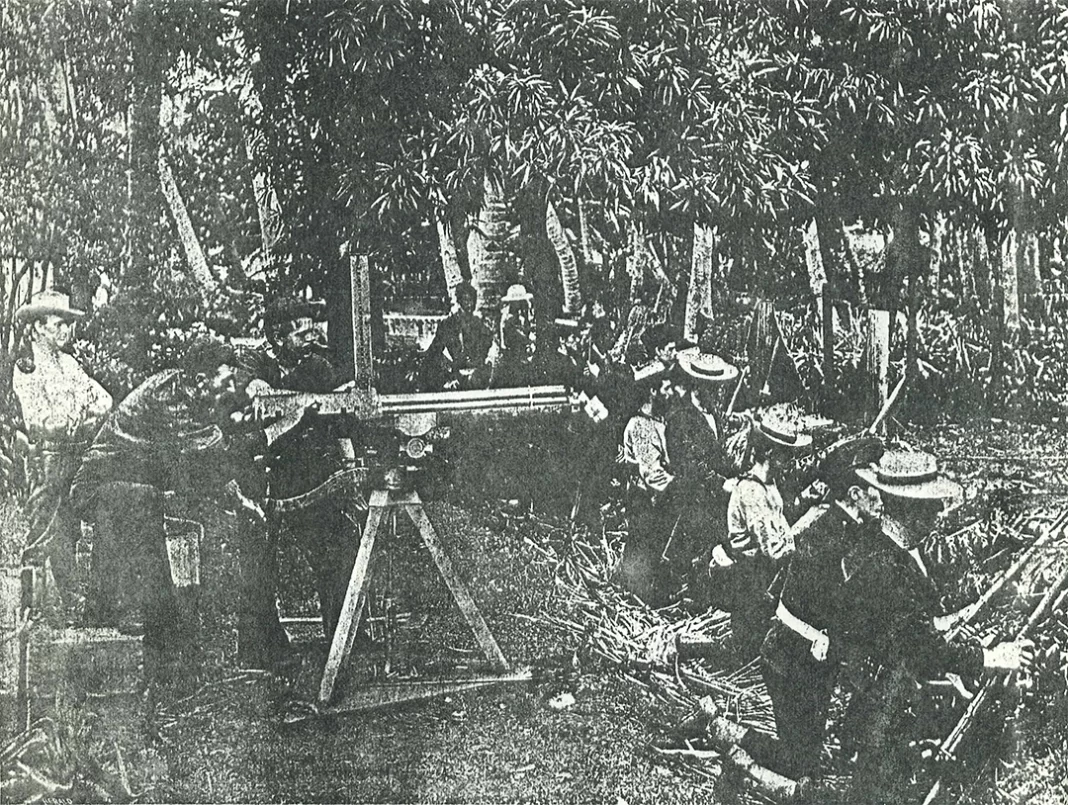In March 1899, fighting began in Apia after Malietoa Tanu was appointed King of Samoa. The conflict involved Samoan factions supported by foreign powers. This account is based on a newspaper report preserved in the personal ledger of H.J. Moors, an American trader who lived in Samoa at the time.
Saturday, 4 March 1899 – Tensions Rise
A few hours after the Chief Justice ruled that Malietoa Tanu should be the rightful King of Samoa, signs of conflict began to appear in the capital. British and American representatives, having guaranteed the safety of the Chief Justice, dispatched naval guards to protect him and other foreign nationals.
“A large fleet of boats was seen crossing the harbour conveying a large body of Mataafa’s followers to the east side of the Municipality.”
Armed groups took up positions along the main roads and in key areas throughout Apia. The British Consulate was fortified, and detachments of bluejackets (naval infantry) were placed under the command of officers like Lieutenant Gaunt and Lieutenant Cave. The U.S. Consul-General Osborn and his family sought refuge at the British Consulate.
That evening, Mata‘afa’s supporters, rejecting the court decision, began surrounding Apia, with their numbers and movement signaling a likely outbreak of violence.
Sunday, 5 March 1899 – The Fighting Begins
“This latter position was held by a party of Savaii natives from Iva, who maintained their position until about 4 o’clock on Sunday when they surrendered without firing a shot…”
Throughout Sunday, Apia became a war zone. Fighting erupted in various locations including Mulivai and Motootua. The Malietoa faction, overwhelmed, retreated and attempted to hold their ground. By the afternoon, most had surrendered or been driven out of the town.
European civilians, caught in the crossfire, sought shelter at the London Mission House, which was designated by the British as a safe zone. Boats ferried civilians between the shore and British naval vessels for protection.
“The fighting which occurred right in the town was a rather severe firing… but beyond a few bullet holes and a few picture frames being broken, no damage was done, and not one white resident was hurt.”
Captain Sturdee of H.M.S. Porpoise played a key role in protecting foreign residents. Despite the tension, there were no European casualties, though panic was widespread.
Monday, 6 March 1899 – Surrender and Refuge
“The Malietoa party had sought the protection from the foes of the British Captain… they still remain under his protection pending instructions from his Government.”
By Monday morning, Malietoa Tanu and his high-ranking allies had surrendered and were granted refuge aboard the British warship Porpoise. The weather turned stormy, and hundreds of Malietoa followers were stranded under heavy rain without shelter. Civilians and crew from the ships delivered food to them until arrangements were made.
Dr. Raffel, president of the Municipal Council, worked alongside British officials to negotiate the safety of prisoners and civilians.
“On this and on other occasions Dr. Raffel’s services were most valuable and as he is deserving of the highest praise for his humane and conciliatory efforts as mediator…”
Many Malietoa supporters who surrendered were taken to Mulinu’u, where they were treated with restraint and civility by Mata‘afa’s forces.
Aftermath
The fighting in Apia was one of the last local conflicts before Samoa was divided under the Tripartite Convention of 1899. That agreement gave:
- Germany control of Western Samoa (Upolu and Savai‘i)
- The United States control of Eastern Samoa (Tutuila and Manu‘a)
- Britain territorial compensation elsewhere in the Pacific
This partition shaped the political destiny of Samoa for over a century. A division that remains today in the separate entities of Independent Samoa and American Samoa.
Did You Know?
- Malietoa Tanu was just 19 years old when declared King.
- H.M.S. Porpoise and S.M.S. Falke were both present in the harbour during the conflict.
- The London Mission House served as a civilian refuge for both British and American nationals.
- The fighting lasted less than 48 hours, yet changed the course of Samoa’s political history.
Coming Next:
“Lines in the Sand: How Samoa Was Divided by Foreign Powers”
An in-depth look at the Tripartite Convention and how Samoa’s sovereignty was split by Germany, the U.S., and Britain in 1899.
Source:
This article is adapted from a historical newspaper clipping dated April 1899, originally preserved in the personal ledger of Mr. H.J. Moors, an American trader and plantation owner who lived in Samoa during the late 19th century. The clipping was part of a compiled collection by Bill Hart, who in 1997 granted permission for it to be copied, used, and published for the benefit of the people of Samoa. The collection is now held by Samoa Newshub for historical research and educational purposes.





